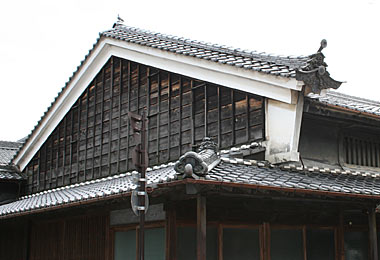|
||
 |
||
1 A term used in the Nara and Heian periods for koyazuka 小屋束 or munazuka 棟束, which were roof struts similar to a kingpost which stood upon the main transverse beam and supported the ridge purlin *munagi 棟木. These struts were spaced at regular intervals within the roof and became a prominent feature of the gable elevations gabled roof structures *kirizuma yane 切妻屋根. In the Nara period the term was noted as udachi 宇立 or 宇太知. In the Heian period, WAMYOUSHOU 倭名抄 (c930) was defined as a post standing upon a beam and the ideogram udatsu was used.
2 Roof struts *tsuka 束 providing direct support for the ridge purlin *munagi 棟木 in Japan's oldest surviving vernacular house *minka 民家, the so-called thousand-year houses sennenya 千年屋 of the Hakogi 箱木 family (15c), Hyougo prefecture, and in certain types of thatched minka, notably on the periphery of the Kansai 関西 region. They usually stand on a longitudinal plate or beam called *jimune 地棟 (a base ridge) and rest upon the principal transverse roof beams. They were comparatively rare in Edo period minka, although they may have been more important in the medieval period and were associated particularly with rafter roof construction *taruki kouzou 垂木構造. There are, however, composite structures in which a *sasuzuka 扠首束 was used in association with the principal rafter *sasu 扠首 in various areas. Usually pronounced odachi or udachi.
3 Pronounced udatsu or udachi. Posts in the gable walls directly supporting the ridge purlin *munamochibashira 棟持柱 in simple dwelling huts or ancillary structures called *udatsuya うだつ家. Found in Yamanashi, Nagano, Shizuoka, Chiba, and Miyagi prefectures and in the Kansai region in the Edo period. The udatsuya were gabled roof structures kirizuma yane and the udatsu were often earthfast posts *hottatebashira 掘立柱.
4 A projection of the gable parapet in urban vernacular houses *machiya 町家 of the capital and its vicinity in the Muromachi period. In so far as it involves extending the vertical roof struts koyazuka, it is distantly related to the udachi or udatsu of definitions 1-3. Examples from this period do not survive but they are shown in contemporary illustrations, notably the 16c *rakuchuu rakugai-zu byoubu 洛中洛外図屏風, sets of folding screens which depict the capital and its environs. There were usually parapet walls at either end of the structure and each was provided with a miniature roof *koyane 小屋根, usually thatched or shingled to protect it from the elements. It is conjectured that this kind of udatsu may have originated as a form of protection from wind and rain for the roof verges *keraba 螻羽 of the closely-packed gable-roofed town houses. The udatsu frame was also extended to create lateral screens *sodeudatsu 袖卯立 filling the trapezoidal space between the deeply overhanging eaves of the main roof and the pent roof *hisashi 廂 below. Whatever its functional origin, it is certain that the udatsu acquired connotations of status and was in use among the more prosperous property owning townsmen. The Japanese saying "udatsu ga agaru 卯立が上がる" (putting up an udatsu ) is a metaphor for achieving independence and a level of worldly success.
5 In the Edo period, a developed form of the type of udatsu defined in 3. Although shingled roofs and shinkabe construction *shinkabe-zukuri 真壁造 persisted until the 19c in some places, the Edo period udatsu was increasingly constructed with the more permanent roof of tile and the frame cased in a fireproof coat of plaster *ookabe-zukuri 大壁造. Thus it acquired the additional function of acting as a firebreak wall. It also retained its significance as a status symbol until the end of the Edo period. In abbreviated examples, the upper parapet walls were omitted and only the sodeudatsu beneath the eaves were constructed. Geographically the udatsu spread from the Kyoto area, where it seems to have evolved, to the machiya of towns along the principal routes, until it had penetrated almost every region of the country from a northern limit around Morioka 盛岡 in Touhoku 東北 region to Kyuushuu 九州 and Shikoku 四国. It was most prominent and elaborate in central Honshuu 本州. Paradoxically, it ceased to be a common feature of Kyoto machiya in the 19c and was not very common in Kantou 関東, where it was sometimes called kiriyoke 霧除. The plastered gable walls *takahei 高塀 of the yamato roof style *yamatomune 大和棟, which came into vogue in the thatched farmhouses of Nara and Osaka during the 18c, was essentially another form of udatsu.

4, Mutou
武藤 house (Gifu)
(C)2001 Japanese Architecture and Art Net Users System. No reproduction or republication without written permission.
掲載のテキスト・写真・イラストなど、全てのコンテンツの無断複製・転載を禁じます。

